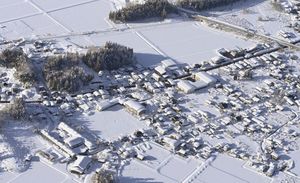Boom Supersonic's XB-1 Prototype Makes History by Breaking the Sound Barrier
The Boom Supersonic XB-1 supersonic jet prototype has achieved a milestone by breaking the sound barrier, marking the advent of the first American civil supersonic aircraft. This momentous event unfolded on January 28, 2025, during a test flight over the Mojave Desert, California.
With the seasoned pilot Tristan "Geppetto" Brandenburg at the controls, the XB-1 soared to altitudes of 35,290 feet, where it reached speeds of Mach 1.12, approximately 750 mph. This test flight has set the stage for Boom's mission to introduce supersonic travel back to civilian aviation, which has remained dormant since the Concorde's retirement.
Previously, only two civilian aircraft—the Franco-British Concorde and the Soviet Tu-144—had successfully exceeded the speed of sound, highlighting the XB-1's groundbreaking achievement. "During the flight, the XB-1 entered the supersonic corridor and reached its peak altitude before accelerating to Mach 1.122, breaking the sound barrier for the first time," Boom Supersonic reported.
Launched initially as part of Boom's broader vision for supersonic travel, the XB-1 is considered the first independently developed non-military jet to cross this auditory frontier. Over the span of 11 test flights conducted since spring 2024, the aircraft underwent rigorous evaluation, testing its systems under increasingly difficult conditions.
Beyond the immediate success of the XB-1, Boom Supersonic has set high aspirations for its future. The company plans to manufacture the Overture, its 64-seat supersonic airliner capable of cruising at Mach 1.7. This design aims to deliver unprecedented travel times; for example, journeys from New York to Rome could take as little as four hours and 40 minutes—a drastic reduction from the current eight hours typically required.
One of the challenges faced by supersonic jets has been sonic booms—disturbances caused by shock waves when planes exceed the speed of sound. The XB-1 aims to pave the way for quieter options, as the Overture will utilize advanced design and materials, including carbon fiber composites. “The Augmented Reality Vision System plays a pivotal role, enhancing runway visibility during takeoff and landing,” noted Brandenburg. This system improves pilot visibility without the complications of conventional movable noses seen on earlier aircraft like the Concorde.
With positive interest from several major airlines, including American Airlines and United Airlines, Boom Supersonic's Overture has already amassed 130 orders and pre-orders from various aviation players. The company has ambitious plans for production, allowing for the manufacturing of up to 66 Overture aircraft annually at its recently completed super factory located in Greensboro, North Carolina.
The global aspiration for supersonic travel contrasts with the unfortunate fate of the Concorde, which struggled with profitability and public perception due to noise issues and high operational costs. While the Concorde frequently catered to wealthy clientele and business travelers, Boom's developments come at a time when the aviation industry is critically examining sustainability, with plans to operate on up to 100% sustainable aviation fuel (SAF) to lessen its environmental impact.
This significant shift could potentially revitalize the market for supersonic travel, taking advantage of modern materials and technological advancements to overcome hurdles of its predecessor. The convergence of improving technology, alongside the desire for faster air travel, paints an optimistic picture for the future of supersonic passenger aviation.
Boom’s strategy indicates its commitment not only to innovation but also to creating sustainable travel solutions, leading us to wonder: Could we soon witness the return of supersonic jets as mainstream travel options? Only time will tell how these developments will shape the future of our skies.



